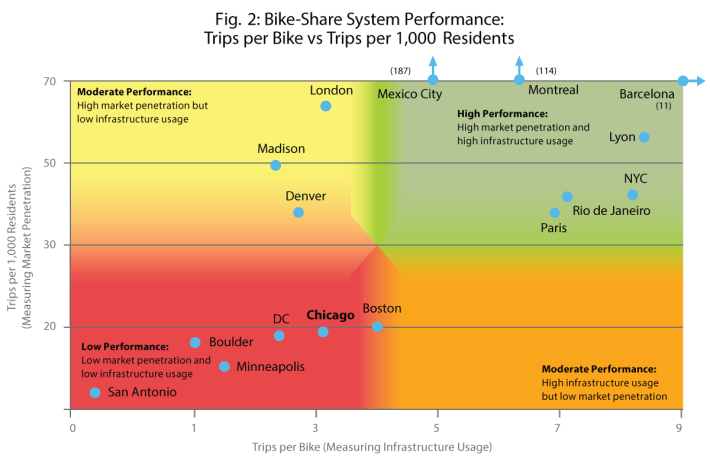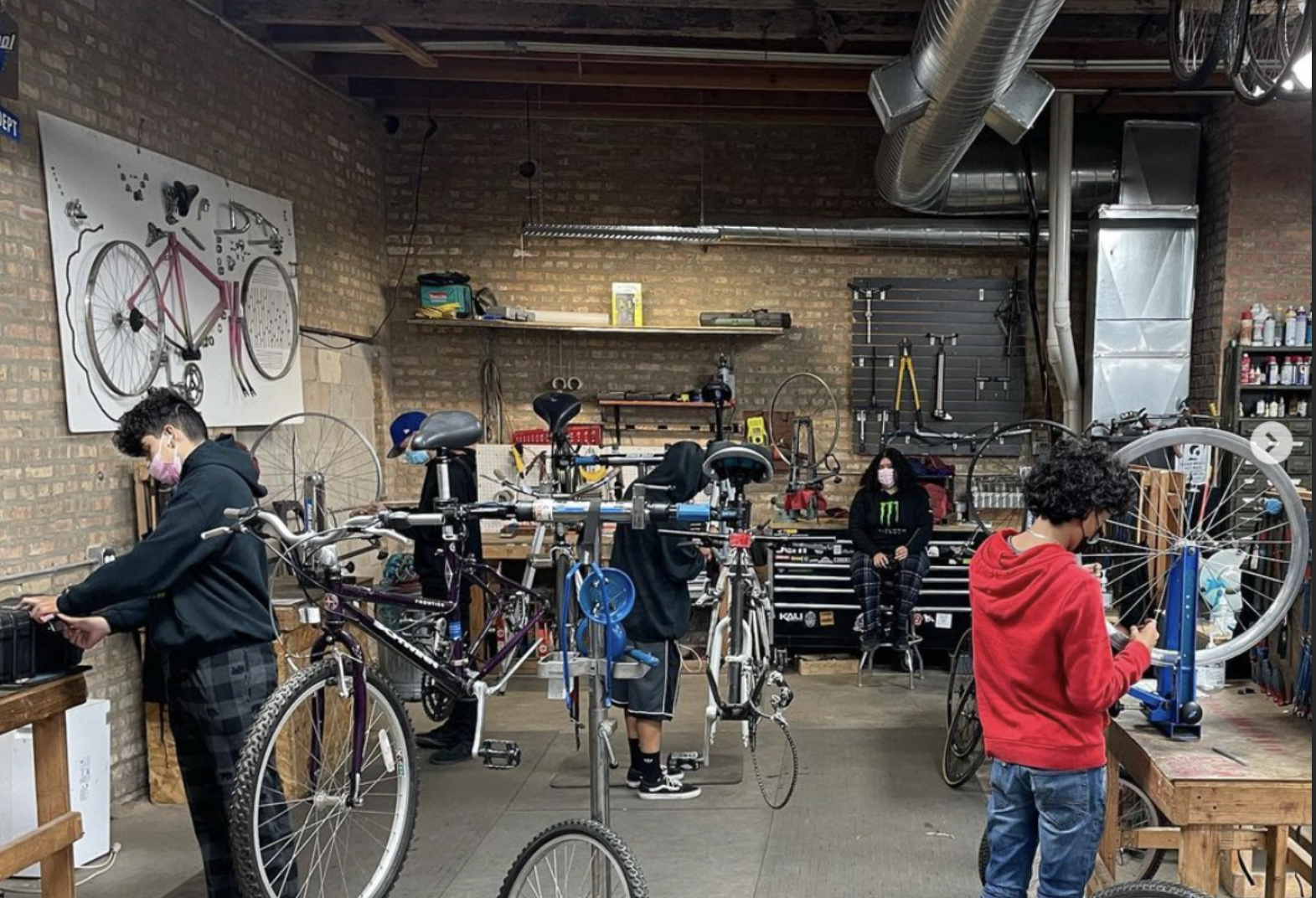Why Divvy Needs to Densify as It Expands
3:51 PM CST on January 7, 2014

For a very new American bike-share system, Divvy is doing well, but it has a lot of room to improve, according to the Institute for Transportation and Development Policy's new Bike Share Planning Guide [PDF]. The guide includes best practices for designing, distributing, and marketing this new form of transit. While Divvy is still growing and hasn't gone through a full peak season yet, the guide illustrates one area where Chicago should focus on improving its bike-share system: station density.
ITDP evaluated Divvy and more than two dozen other bike-share systems according to two basic metrics: daily trips per bike (a.k.a. "system efficiency") and trips per capita (or "market penetration"). The guide says between four and eight trips per bike is a good range. Fewer than four daily trips per bike, and there's too much slack in the system. More than eight, and the availability of bikes and docks will suffer. (This is a problem New York City has seen, even outside rush hour.)
In Divvy's peak 30-day period, the system saw just over three daily trips per bike, below ITDP's recommended range. Sean Wiedel, assistant commissioner at the Chicago Department of Transportation, pointed out that Divvy continued to expand through the summer and fall. Because ITDP's guide was written while Divvy was still rolling out stations, he said, it gives an incomplete picture of system performance. Looking at American cities that launched bike-share networks a year or more before Chicago, he said, Divvy "is on par with systems that have been in operation considerably longer."
Divvy will probably gain steam in the year ahead. To reach the level of use of the most successful systems, though, planners will have to increase station density as the system expands.
Colin Hughes, one of the guide's authors and ITDP's policy director in D.C., clarified that the 30-day period they analyzed in Chicago occurred before all current Divvy stations were online. He then recommended that to improve Divvy's "mobility performance" planners should focus first on "increasing station density significantly within the coverage zone." He added that Divvy could improve performance by also increasing the number of bikes or by having more stations with fewer docks.
The ITDP guide recommends that stations should be spaced about 300 meters, or 984 feet, apart from each other. This is the same station density that Chicago's bike-share RFP sought for "most of the implementation zone." But most Divvy stations -- especially ones outside downtown -- don't meet this standard. Using data from Alex Soble's Divvy Brags application, I found that only 34 out of 300 Divvy stations have at least one station within a 300 meter bike trip.
The RFP said stations in outlying areas "or areas of lower demand" should have other stations located between 300 and 500 meters apart. Of all the current Divvy stations, 183 -- or 61 percent -- are within 500 meters of another station.
Divvy stations are densest in downtown, West Town/River West, West Loop, and Cabrini Green. There are especially high concentrations of Divvys near Union Station and Ogilvie Transportation Center, reflecting the importance of using bike-share extend the reach of transit.
Stations near Washington Park have the lowest connectivity, with the station at Prairie Avenue & Garfield Boulevard a full 1.2 miles from the nearest other station. Additionally, the stations in Washington Park and Hyde Park have 22-37 stations within 5 miles (what you can bike in 30 minutes at 10 mph) while downtown stations have over 200 within 30 minutes travel time. Granted, the number of destinations in Washington Park is different than in the neighborhoods with a greater concentration of stations, but the population density doesn't change much, and bike-share users need to be able to "bike and park anywhere...easily and conveniently," ITDP's guide notes.

Divvy will grow by 175 stations this year, adding 1,750 bicycles. Stations will be added to expand the coverage area, but also to add more stations in the existing coverage area. Wiedel says that infill stations will comprise approximately 20 percent of the system expansion. The coverage area, Wiedel described, would expand to Howard Street in the north, 79th Street in the south, and Kedzie Avenue on the west, and reach closer to the lakefront as you move north and south.
In addition to distance between stations, bike-share systems should be planned to have "a more or less uniform station density throughout the coverage area," according to the ITDP guide. Divvy's station density varies greatly, and Hughes said the system has "half of the minimum station density that ITDP would recommend."
When I tweeted that the station at Prairie/Garfield was the "most disconnected" one, 3rd Ward Alderman Pat Dowell agreed, tweeting back, "You're right. A new station will be at 51st between Prairie and King (tbd) this year. The Garfield CTA station is a transit hub." However, the 3rd Ward, with nine stations, has a density of less than one per square kilometer, and even with a 20 percent increase would remain below ITDP's minimum recommendation.
With 175 more stations set to go online in 2014, and possibly 75 more after that (for a total of 550), between 35 and 50 bike-share stations should be added to the existing zone, improving connectivity for many neighborhoods. However, according to Hughes, Divvy needs to double or triple station density from the current four stations per square kilometer to reach the top-tier performance of the systems in New York City, Montréal, or Mexico City. Even 50 stations to fill out the existing system may not be enough.
Stay in touch
Sign up for our free newsletter
More from Streetsblog Chicago
It’s electric! New Divvy stations will be able to charge docked e-bikes, scooters when they’re connected to the power grid
The new stations are supposed to be easier to use and more environmentally friendly than old-school stations.
Today’s Headlines for Tuesday, April 23
Communities United: Reports of Bikes N’ Roses’ death have been greatly exaggerated
According to the nonprofit shop's parent organization, BNR has paused its retail component, but is still doing after-school programming and looking for new staff.



